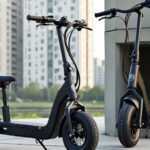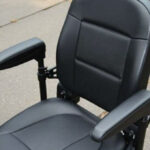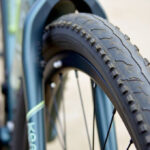No air bike tires, also known as airless tires, are a game-changer in cycling. They eliminate the headaches caused by traditional pneumatic tires—such as flats, punctures, and constant air pressure maintenance. For anyone searching for an eco-friendly, hassle-free biking solution, here’s what you need to know right away:
- No flats, ever: Airless tires are puncture-proof.
- Durable: These tires can last up to 3,000 miles.
- Easy to install: You can use your existing rims.
- Lightweight: Made from materials like multi-cell foam.
Airless tire technology isn’t entirely new; it was initially developed with heavy machinery and military vehicles in mind. Recent advancements have made it viable for everyday cyclists. Systems like Tannus Airless Tires are crafted from patented multi-cell foam and can be locked onto your current rims with ease.
Benefits: Puncture-proof design, zero maintenance, long lifespan, and improved durability make daily rides smoother and more reliable.
Challenges: Higher weight, increased rolling resistance, and a possible trade-off in performance compared to traditional air-filled tires.
To sum up, no air bike tires offer a host of benefits for active, eco-conscious riders but come with their own set of challenges. We’ll dive deeper into these aspects in the following sections.

No air bike tires word guide:
The Evolution of No Air Bike Tires
The journey of no air bike tires is fascinating, rooted in advanced technology and innovative materials. Initially, airless tire technology was developed for heavy machinery and military vehicles, where durability and puncture resistance were crucial.
NASA Technology
A significant leap in airless tire technology came from NASA. Engineers at NASA designed airless tires using a nickel-titanium alloy, also known as Nitinol. These tires were created to withstand the harsh conditions of space missions, offering exceptional strength and flexibility. The same principles are now being applied to bike tires, providing cyclists with robust, reliable options.
Nickel-Titanium Alloy
The use of nickel-titanium alloy in airless tires is revolutionary. Nitinol has unique properties that allow it to return to its original shape after deformation. This makes it perfect for tires that need to endure rough terrains without losing their form or functionality. While this technology is still being refined for everyday use, its potential is immense.
Advancements in Materials
Modern airless bike tires leverage a variety of advanced materials. One popular choice is thermoplastic polyurethane (TPU). TPU is known for its durability and elasticity, making it ideal for tires that need to be both tough and flexible. Another innovative material is multi-cell foam, which provides a lightweight yet sturdy structure, ensuring a smooth ride without the risk of flats.
Historical Context
Historically, the concept of airless tires isn’t new. Early versions were bulky and inefficient, primarily used in industrial settings. However, with advancements in materials and technology, airless tires have evolved significantly. Today’s airless bike tires are lighter, more efficient, and designed with the everyday cyclist in mind.

In summary, the evolution of no air bike tires has been driven by cutting-edge technology and material science. From NASA’s space missions to the streets we ride on, these innovations promise a future where flat tires are a thing of the past.
Next, we’ll explore the numerous benefits that airless bike tires bring to the table.
Benefits of Airless Bike Tires
Airless bike tires, also known as no air bike tires, bring a host of benefits that make them an attractive choice for many cyclists. Let’s explore some of the key advantages.
Puncture-Proof
One of the most significant benefits is that these tires are puncture-proof. Traditional tires can be a hassle, especially when you run over sharp objects like nails or glass. With airless tires, this worry is eliminated. The solid construction means you won’t ever have to deal with flats, making your rides more reliable and stress-free.
Maintenance-Free
Another major advantage is that airless tires are maintenance-free. According to Schwalbe, their Airless System can roll for up to 10,000 kilometers without the need for any maintenance, pumping, or repairs.
“With comfort, durability and zero maintenance, our Airless System offers a real alternative to the inner tube!” — René Marks, Schwalbe Product Manager Touring
Durability
Durability is a standout feature of airless bike tires. Made from advanced materials like thermoplastic polyurethane (TPU) and multi-cell foam, these tires are built to last. They can withstand various weather conditions and rough terrains, ensuring a long lifespan. The E-TPU foam used in Schwalbe’s Airless System provides exceptional elasticity and recovery, making these tires robust and long-lasting.
Fuel Economy
For e-bike users, airless tires can contribute to better fuel economy. Since you won’t have to worry about under-inflated tires, which can increase rolling resistance and energy consumption, your e-bike’s battery life can be optimized. This means longer rides on a single charge, making your e-bike more efficient.
Trunk Space
Airless tires also save trunk space. If you’re someone who often carries a spare tube, pump, and other repair tools, you’ll appreciate the extra space you gain by switching to airless tires. No need for bulky repair kits; just enjoy the ride.
Eco-Friendly
Lastly, airless bike tires are more eco-friendly. Traditional tires often end up in landfills due to frequent replacements and punctures. Airless tires, with their long lifespan and durable materials, reduce waste and the need for constant replacements. This makes them a more sustainable choice for environmentally conscious cyclists.
In summary, the benefits of airless bike tires—puncture-proof, maintenance-free, durable, fuel-efficient, space-saving, and eco-friendly—make them a compelling option for various types of cyclists. Whether you’re a commuter, a casual rider, or an e-bike enthusiast, these tires offer a hassle-free and reliable riding experience.
Next, we’ll discuss the challenges and limitations that come with airless bike tires.
Challenges and Limitations
While no air bike tires offer many benefits, they also come with some challenges and limitations. Here are the main concerns to consider:
Heavier Weight
One of the most significant drawbacks of airless bike tires is their heavier weight. Unlike traditional tires filled with air, these tires are made from solid materials like thermoplastic polyurethane (TPU) and multi-cell foam. This added weight can affect the overall performance of your bike, especially during long rides or uphill climbs. Cyclists may find it harder to accelerate quickly and maintain high speeds.
Rolling Resistance
Another critical issue is rolling resistance. Airless bike tires generally have higher rolling resistance compared to their air-filled counterparts. This means you’ll need to exert more effort to pedal, which can be tiring over long distances. The increased resistance can also impact the battery life of e-bikes, requiring more frequent charges.
Performance Loss
Due to the heavier weight and increased rolling resistance, there can be a noticeable performance loss. Cyclists who are used to the responsiveness and agility of traditional tires may find airless tires lacking in these areas. This can be particularly concerning for competitive cyclists or those who prioritize speed and efficiency.
Specialist Fitting Required
Installing airless bike tires often requires a specialist fitting. Unlike traditional tires that you can easily replace at home, airless tires may need professional installation. This can add to the initial cost and inconvenience, especially if you don’t have access to a nearby specialist retailer.
Despite these challenges, many cyclists find that the benefits of airless bike tires outweigh the drawbacks. However, weigh these limitations carefully to determine if they are the right fit for your cycling needs.
Next, we’ll explore the popular airless bike tire systems available in the market.
Popular Airless Bike Tire Systems
Airless bike tires have come a long way thanks to advancements in materials and technology. One of the most innovative systems on the market today uses thermoplastic polyurethane (TPU) and multi-cell foam to deliver a ride experience similar to traditional air-filled tires.
Thermoplastic Polyurethane (TPU)
Thermoplastic polyurethane, or TPU, is a highly elastic material that provides the perfect balance between durability and comfort. In advanced airless systems, TPU is used to create a series of tiny, hermetically sealed air bubbles. These bubbles form a highly elastic air cushion that absorbs shocks and offers a smooth ride.
Multi-Cell Foam
The multi-cell foam used in airless tires is made up of thousands of tiny, interconnected cells. This structure mimics the properties of air-filled tires by compressing and rebounding effectively. The material springs back to its original position more efficiently, providing a ride that feels similar to traditional tires.
Long Lifespan
One of the standout features of airless bike tires is their long lifespan. Some systems can roll for up to 10,000 kilometers without requiring any maintenance. This makes them an excellent choice for commuters, rental bike providers, and e-bike users who prioritize convenience and reliability.

In summary, advanced airless technology offers a compelling alternative to traditional bike tires. The use of thermoplastic polyurethane and multi-cell foam provides durability and comfort, while the long lifespan of these tires makes them a worthy consideration for many cyclists.
Frequently Asked Questions about No Air Bike Tires
Are no air tires good?
No air bike tires offer several advantages that make them a great option for many cyclists. One of the most notable benefits is their durability. For example, some airless tires are designed to last up to 3,000 miles without going flat. This means you won’t have to worry about punctures or frequent replacements.
Another advantage is improved fuel economy for e-bikes. Since airless tires maintain consistent pressure, they can contribute to better battery efficiency. Additionally, these tires save trunk space because you won’t need to carry a pump or spare tubes.
What is the problem with airless bike tires?
While there are many benefits, no air bike tires also come with some challenges. One of the primary issues is their heavier weight compared to traditional tires. The materials used, such as thermoplastic polyurethane (TPU) and multi-cell foam, add extra weight, which can affect the bike’s overall performance.
Another concern is rolling resistance. Airless tires may not roll as smoothly as air-filled ones, which can lead to a slight decrease in speed and efficiency. This is particularly noticeable when riding on uneven or rough surfaces. Additionally, some airless systems require specialist fitting, which means you’ll need to visit certified retailers for installation.
Are there airless bicycle tires?
Yes, there are several advanced airless bicycle tires available on the market today. These tires are designed to be maintenance-free, eliminating the need for regular pressure checks and puncture repairs. Advanced airless systems use innovative materials such as TPU and multi-cell foam to provide a ride experience similar to traditional tires.
For instance, some airless systems can last up to 10,000 kilometers without any maintenance, making them an excellent choice for commuters and e-bike users. These tires are not only durable but also offer a smooth and comfortable ride thanks to their advanced materials and design.
In summary, while no air bike tires have some drawbacks like heavier weight and rolling resistance, their durability and maintenance-free nature make them a compelling option for many cyclists.
Conclusion
At Doot Scoot, we are committed to leading the way in sustainable urban mobility. No air bike tires are a crucial part of this vision. These tires offer a durable, maintenance-free option for cyclists, making them ideal for eco-conscious urban dwellers.
Eco-friendly solutions are at the heart of our strategy. Airless tires reduce waste by eliminating the need for frequent replacements and puncture repairs. This aligns perfectly with our mission to promote green transportation options.
Urban mobility is more important than ever. With more people living in cities, efficient and reliable transportation is essential. No air bike tires provide a dependable solution that can withstand the rigors of city commuting. They require less maintenance, meaning fewer interruptions and a smoother ride for urban cyclists.
Looking ahead, we see future growth in the adoption of airless technology. Advances in materials and design will continue to improve the performance and appeal of these tires. At Doot Scoot, we are excited to be at the forefront of these developments, offering our customers the best in innovative cycling solutions.
Our customer-centric approach ensures that we prioritize the needs and preferences of our community. We provide comprehensive guides, expert reviews, and top-notch customer support to help you make informed decisions.
Join us at Doot Scoot in embracing the future of sustainable urban transport. Explore our offerings and find how no air bike tires can improve your cycling experience.
Find more about Doot Scoot and our commitment to eco-friendly urban mobility.










